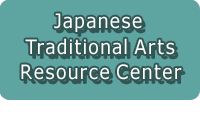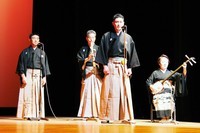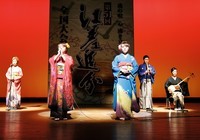

Total:35items
- Folk Performing Art (16)
- Kenbai: Sword Dance
- Kirin Shishimai: Kylin Lion Dance
- Yoshiwa Taiko Odori: Yoshiwa Drum Dance
- Omiya Odori: Omiya Dance
- Tsurusaki-Odori festival
- Omi Take-no-karakai (Tug-of-wars with bamboo)
- Nakizumo: Crying Baby Sumo
- Ryugasaki Tsukumai:Ryugasaki Acrobatic Performance
- Mikawa Manzai
- Esashi Oiwake: Esashi Folk Singing
- Ayado Yonenbutsu and Bon festival dance
- Occhi-no-Ohinagayu (rice porridge offering for the Doll's Festival in Occhi)
- Hanatori-odori Dance (Masuda area)
- Kaga-manzai
- Rice Planting festival of Tsutsukowake Shrine
- Edo sato kagura: Edo folk dance for entertaining god
- Kabuki (2)
- Noh & Kyogen (1)
- Festival (10)
- Ritual & Ceremony (2)
- Puppet Play (2)
- Folk technology (2)

 |
|
 《Feature》
《Feature》"Esashi Oiwake" is one of the representative folk ballads of Japan. Its origin and the beginning of its history are not known because of the lack of literature; however, it is considered that Esashi Oiwake has its roots both in Magouta in Shinshu (current Nagano Pref., Central Japan) and in Ise (current Mie Pref., West Japan) Matsuzaka-bushi.
Magouta of Shinsyu Nakasendo was first brought down to Echigo (current Niigata Pref., Central Japan) area. Then, Echigo Oiwake was developed as sea chantey. The rhythm of leading horses transformed into a chantey sung by fishermen, Echigo Oiwake.
This was brought to Esashi by the boatmen and sailors who regularly visited Ezo, current Hokkaido. Successful businessmen, people who established their wealth by herring-fishing, and boatmen sang it while they had drinking party with women.
On the other hand, Ise Matsuzaka-bushi was arranged by Kaneyoshi Matsuzaki and became Matsuzaka Kuzushi. It was sung as Kaneyoshi-bushi in Echigo area on celebratory occasions. This folk song became popular among common people and finally reached Esashi.
Esashi Oiwake is considered to be developed from these two folk songs as its basis. It also absorbed various elements of other songs brought by Kitamaebune, a sort of cargo-vessels which conducted trade between different cities. It was developed as Esashi Oiwake, with a unique sentiment of Esashi, the city with fishing grounds and commercial port.
A Japanese lute player, Ichinojo Sanoya, known as Sanoichi, played an important role in the development of Esashi Oiwake. One of the lyrics goes that the beginning of Oiwake is Saniochi Bonze, and the beginning of Geisha is Kameko of Tsutaya.
Sanoichi was a Japanese lute player from Morioka (Iwate) in Kansei period (1789~1801), who is said to have composed a phrase, "If there is a fork in the way of love, we would not get lost." His monument ca be found in the precincts of Higashi Hongan-ji temple, where the memorial service is held on the day before the Esashi Oiwake National Convention every year.
Amongst the three parts of Esashi Oiwake, Mae-uta, Hon-uta, and Ato-uta, main body is definitely Hon-uta. It is said that a mendicant Zen priest with a flute, Daijiro Oshima from Nambu Mizusawa, adapted Mae-uta of Oiwake from the sea chanty he mastered in Echigo area in 1890, and after that, Shudoshi Uchida who was a Kinko school shakuhachi (bamboo flute) player from Kobe came and added Ato-uta, in 1921.
There were various schools of Esashi Oiwake. In 1908, Genzaburo Hirano encouraged each master to unify the schools of Esashi Oiwake and to establish Esashi Oiwake study group. As a result, current Esashi Oiwake became established as the Orthodox Esashi Oiwake.
Hirano was an apprentice to a mistress of shamisen, called Grandmother Komasu. The songs by Grandmother Komasu are regarded as the original of the Orthodox Esashi Oiwake. Hirano, who learned from Grandmother Komasu, established and spread the Hirano school of the Orthodox Esashi Oiwake towards the end of 19th century and started to research how to record Esashi Oiwake on a musical score.
After that, the master Hirano and his group made continued efforts to create a standard score. In 1911, current scores which uniquely consist of seven lines were created. Hirano published this score when he held a recital of the Orthodox Esashi Oiwake in Tokyo and he successfully stylized Esashi Oiwake.
It is specified that Hon-uta of the Orthodox Esashi Oiwake consists of seven melodies which should be finished singing between two minutes and twenty seconds and two minutes and twenty five seconds. The first melody represents the feeling of gradually going down from the top of a big wave to the sea-bottom, whereas the second melody must convey a gradual transition into buoyant mood. The third melody again draws itself into the depth of the sea, then the fourth melody describes sadness. The fifth melody, as the hook-line, shows the strong emotion which is as passionate as coughing up blood. The sixth melody recurs the sinking mood of the third melody, and the seventh melody ends the tune with the melancholic feeling of the fourth melody.
During the war, Esashi Oiwake disappeared for some time, yet after the war, in 1947, Esashi Oiwake Association was reorganized. Since then, Esashi Oiwake became popular once again and was established as one of the representative Japanese folk ballads.
[Intangible Folk Cultural Asset of Hokkaido]
Provided by Esashi Oiwake Section, Division of Commerce, Industry, and Sightseeing, Esashi Oiwake Association
Translation: Yoko Hokari, reviewed by Moe Shoji
| City/Town | Esashi-cho, Hiyama-gun, Hokkaido |
|---|---|
| Location | 【Esashi Oiwake National Convention】
Esashi-cho, Hiyama-gun, Hokkaido |
| Contact | Esashi Oiwake Section, Division of Commerce, Industry, and Sightseeing, Esashi Oiwake Association
193-3 Nakauta-cho, Esashi-cho, Hiyama-gun, Hokkaido, 043-0034 TEL +81(0)139-52-5555 / FAX +81(0)139-52-5544 (Japanese only) |
| Highlight/POI | Esashi Oiwake is not a song only for the singers with beautiful voices. A person with high tone, hoarseness, or deep voice, everyone has their distinctive charms. Because Esashi Oiwake identifies with the emotions of Japanese people, it is widely loved. The themes of Esashi Oiwake include the labor and life as well as all the emotion of sorrow, hardness, and beauty. |
| General Participation | 【Esashi Oiwake Seminar】
Esashi Oiwake Seminar is held by special instructor for Esashi Oiwake lovers throughout the country. Please click here for the detail. 【Esashi Oiwake National Convention】 Esashi Oiwake National Convention is a special event held in Esashi, the home of this folk song. 440 singers of Esashi Oiwake selected from across the country compete in their singing voice. Please click here for the detail. Assistance needed? For inquiries in English: JTCO Contact Form Your inquiries will be forwarded by JTCO in Japanese to the organization you wish to contact. |
| URL | http://esashi-oiwake.com/ |



